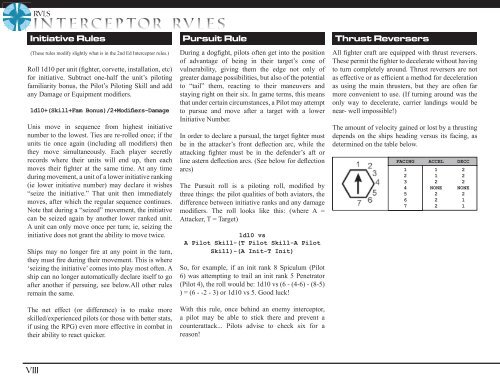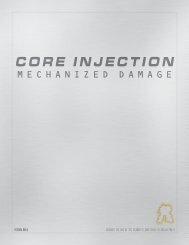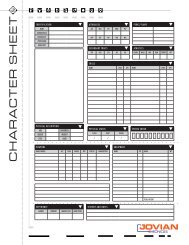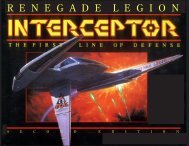renegadelegionneveren dingoffensive - Catsden.net
renegadelegionneveren dingoffensive - Catsden.net
renegadelegionneveren dingoffensive - Catsden.net
You also want an ePaper? Increase the reach of your titles
YUMPU automatically turns print PDFs into web optimized ePapers that Google loves.
RVLS<br />
I N T E RC E P TO R RV L E S<br />
Initiative Rules<br />
(These rules modify slightly what is in the 2nd Ed Interceptor rules.)<br />
Roll 1d10 per unit (fighter, corvette, installation, etc)<br />
for initiative. Subtract one-half the unit’s piloting<br />
familiarity bonus, the Pilot’s Piloting Skill and add<br />
any Damage or Equipment modifiers.<br />
1d10+(Skill+Fam Bonus)/2+Modifiers-Damage<br />
Unis move in sequence from highest initiative<br />
number to the lowest. Ties are re-rolled once; if the<br />
units tie once again (including all modifiers) then<br />
they move simultaneously. Each player secretly<br />
records where their units will end up, then each<br />
moves their fighter at the same time. At any time<br />
during movement, a unit of a lower initiative ranking<br />
(ie lower initiative number) may declare it wishes<br />
“seize the initiative.” That unit then immediately<br />
moves, after which the regular sequence continues.<br />
Note that during a “seized” movement, the initiative<br />
can be seized again by another lower ranked unit.<br />
A unit can only move once per turn; ie, seizing the<br />
initiative does not grant the ability to move twice.<br />
Ships may no longer fire at any point in the turn,<br />
they must fire during their movement. This is where<br />
‘seizing the initiative’ comes into play most often. A<br />
ship can no longer automatically declare itself to go<br />
after another if persuing, see below.All other rules<br />
remain the same.<br />
Pursuit Rule<br />
During a dogfight, pilots often get into the position<br />
of advantage of being in their target’s cone of<br />
vulnerability, giving them the edge not only of<br />
greater damage possibilities, but also of the potential<br />
to “tail” them, reacting to their maneuvers and<br />
staying right on their six. In game terms, this means<br />
that under certain circumstances, a Pilot may attempt<br />
to pursue and move after a target with a lower<br />
Initiative Number.<br />
In order to declare a pursual, the target fighter must<br />
be in the attacker’s front deflection arc, while the<br />
attacking fighter must be in the defender’s aft or<br />
line astern deflection arcs. (See below for deflection<br />
arcs)<br />
The Pursuit roll is a piloting roll, modified by<br />
three things: the pilot qualities of both aviators, the<br />
difference between initiative ranks and any damage<br />
modifiers. The roll looks like this: (where A =<br />
Attacker, T = Target)<br />
1d10 vs<br />
A Pilot Skill-(T Pilot Skill-A Pilot<br />
Skill)-(A Init-T Init)<br />
So, for example, if an init rank 8 Spiculum (Pilot<br />
6) was attempting to trail an init rank 5 Pe<strong>net</strong>rator<br />
(Pilot 4), the roll would be: 1d10 vs (6 - (4-6) - (8-5)<br />
) = (6 - -2 - 3) or 1d10 vs 5. Good luck!<br />
Thrust Reversers<br />
All fighter craft are equipped with thrust reversers.<br />
These permit the fighter to decelerate without having<br />
to turn completely around. Thrust reversers are not<br />
as effective or as efficient a method for deceleration<br />
as using the main thrusters, but they are often far<br />
more convenient to use. (If turning around was the<br />
only way to decelerate, carrier landings would be<br />
near- well impossible!)<br />
The amount of velocity gained or lost by a thrusting<br />
depends on the ships heading versus its facing, as<br />
determined on the table below.<br />
FACING ACCEL DECC<br />
1<br />
2<br />
3<br />
4<br />
5<br />
6<br />
7<br />
1<br />
1<br />
2<br />
NONE<br />
2<br />
2<br />
2<br />
2<br />
2<br />
2<br />
NONE<br />
2<br />
1<br />
1<br />
The <strong>net</strong> effect (or difference) is to make more<br />
skilled/experienced pilots (or those with better stats,<br />
if using the RPG) even more effective in combat in<br />
their ability to react quicker.<br />
With this rule, once behind an enemy interceptor,<br />
a pilot may be able to stick there and prevent a<br />
counterattack... Pilots advise to check six for a<br />
reason!<br />
VIII





